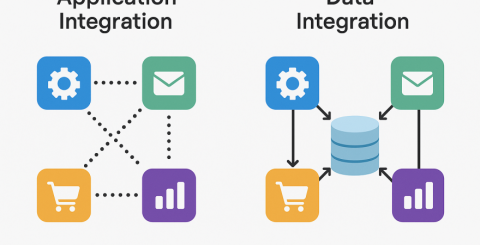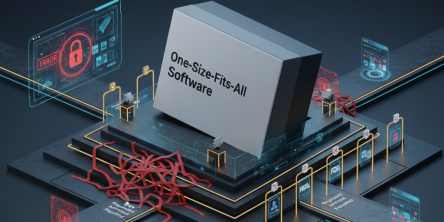Comparing Application and Data Integration: What Sets Them Apart

Thanks to cloud computing, specialized SaaS apps have become rather accessible. At the same time, the amount of data generated by these applications and external sources is growing at an exponential pace. But all this critical data is frequently spread across multiple disconnected systems. So, what the modern enterprise needs is for its various technological components to work together harmoniously. Applications must be able to automatically share information and initiate actions with one another. Data must be accessible and reliable throughout the organization whenever and wherever it is required. The endeavors to overcome the challenges posed by fragmented applications and scattered data leads companies to two possible solutions: application integration and data integration. Unfortunately, the market has observed a tendency to confuse these two distinctive processes.
In this blog, I will discuss the main differences between app integration and data integration based on the most important factors. Then you can decide if you need to hire an application integration company or one that offers data integration services.
App Integration vs. Data Integration: Top Differences Worth Noting
Often used when companies want to upgrade their digital infrastructure or optimize processes, the terms "app integration" and "data integration" are not synonymous. They have separate functions and involve different procedures, even though both are essential to creating a cohesive IT ecosystem. Knowing the distinctions between data integration and application integration is crucial to choosing the best strategy depending on your operational objectives, technological stack, and business requirements. Let's examine the main differences that make them unique.
- Area of focus: When working to connect multiple apps, the primary goal is to connect different software applications. Why? Well, these apps can interact and communicate with one another directly. The emphasis is on integrating system functionalities and business processes across multiple apps. Whereas in data integration, the name indicates the focus area: the data itself. It aims to combine data from various sources into a single, consistent view or location.
- Primary purpose: The primary goal of application integration is to automate workflows and business processes that span multiple distinct apps. This allows for real-time or near-real-time communication and action triggers between systems to improve operational efficiency and break down functional silos. Whereas data integration seeks to consolidate data for use in reporting and analytics.
- Data types involved: Application integration typically deals with specific data points or transactional data associated with events that trigger actions between apps. Interestingly, it is frequently done so in discrete units as data flows through a process. Data integration, on the other hand, deals with a much broader range of data types, such as large volumes of historical data and transactional data. All these data types are frequently processed in batches with the goal of consolidating data from multiple sources.
- Tools used: Common application integration tools include iPaaS and API management platforms among others. The list also includes messaging queues that manage the flow of requests and data between systems via APIs or message protocols. Data integration tools are designed for entirely different purposes, including ETL and ELT. Data integration also needs systems such as data warehousing platforms and master data management systems.
- Processes: Application integration processes are frequently event driven; defining how an action or data change in one app causes a specific response or action in another application. APIs, web services, etc. are commonly used to orchestrate interactions based on business logic. Whereas with data integration processes, you get a series of steps that include extracting data from source systems and then loading it into a target repository such as a data warehouse or database.
- Key challenges: App integration means managing the complexity of connecting multiple applications with different APIs. Then there is also data formats or high availability of connections. Significant challenges in data integration include managing the volume and variety of data from multiple disparate sources. These factors are elemental to all pursuits aimed at ensuring high data quality and governance across the consolidated data.
App Integration Use Cases You Ought to Know
- Banking: It connects online banking platforms with core banking systems to help process transactions and display account information and too in real time
- Healthcare: Application integration links EHR systems with laboratory or imaging systems to automatically transfer patient results into their digital charts
Most Notable Data Integration Use Cases
- Analytics: Data integration gathers and consolidates data from various source systems into a unified dataset that is suitable for comprehensive analysis.
- Business Intelligence: For BI, data integration combines data from different departments and systems with a consistent view to enable accurate reporting. It also helps with dashboards for strategic decision-making
Final Words
Well, folks, that sums it up. Will you opt for an application integration company or a data integration service provider?
Similar Articles
In the world of finance, speed and accuracy are everything. Decisions made a day late can cost millions, and delayed visibility into financial performance can leave even the best organizations blind to risks.
Discover the best tools to enhance employee recognition, boost morale, and create a more motivated, engaged workplace culture.
At first glance, off-the-shelf software appears to be a dream come true. They are quick to set up, cheaper upfront, and marketed as “universal.”
A modern business must continually adapt. This bit everyone seems to know.
The modern healthcare industry is undergoing a significant transformation. The models of healthcare that we are used to thus far are now making way for a more data driven approach
In the modern world, maintaining good health often feels like a constant challenge. Between busy lifestyles, sedentary habits, and lack of motivation, many people find it difficult to stay consistent with exercise, diet, or wellness practices.
Every news publisher's dream, or just getting started, hits that wall sooner or later. What do you build your site on? You’ve basically got two roads: WordPress or custom development.
Discover key features construction teams need in permit tracking software to boost efficiency, stay compliant, and streamline project management.
Let’s be honest – managing royalties isn’t exactly the fun part of working in media or publishing, but it is very important because it protects the creator’s rights and work ownership.








